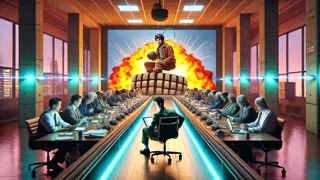Introduction
Every morning, as dawn light filtered through the dusty blinds of his modest Brooklyn apartment, Walter Mitty rose from his narrow twin bed with the same deliberate step that marked his routine. He brushed the crestfallen look from his face and donned his faded gray suit, slipping into the role of a man whose greatest adventures occurred between the pages of his own imagination. In the silent hush before his alarm’s second chime, he allowed his mind to wander, conjuring daring journeys that stretched from Arctic tundras to bustling city plazas. There, in the secret chambers of his thoughts, he was no longer a mild-mannered photo editor for Hudson & Clarke Publishing; he was a fearless aviator charting unknown skies or an undercover agent defusing ticking bombs within seconds of oblivion. Each fleeting fantasy shimmered with vivid color against the muted reality of his cubicle, where stacks of negatives and half-typed captions bore witness to his extraordinary internal life. Yet when the moment came to rejoin reality, Walter folded each daydream away like a delicate photograph, tucking it into the recesses of his mind, ready to be retrieved at the slightest spark of monotony. In those darkened studios and hurried deliveries, he clung to hope that one day he might bridge the gap between dream and deed, forging a path toward a life where his imagination was not merely a refuge but a force to shape the world around him. And with that thought warming his heart, he stepped out into the crisp morning air, his eyes brighter than they had been in years. In the commute that followed, amid the clattering subway cars and the tide of hurried faces, he was both invisible and endless, slipping into new personas at each red light, his heartbeat syncing with the cadence of his own secret odyssey. And though no one in his orbit suspected the depth of his inner life, every suppressed smile, every lingering stare meant something far grander than any holdup in the city’s rhythm.
A Glimpse Beyond the Ordinary
In the sprawling corridors of Hudson & Clarke Publishing, Walter’s hands moved with mechanical precision. He shifted slides, labeled negatives, and typed terse captions, all while knowing that something larger than his work awaited behind the veil of his mind. When he pressed his glasses to the bridge of his nose, his gaze would drift past the glass pane in front of him, carrying him away from the hum of fluorescent lights into a realm where the ordinary mutinied and offered itself up for reinvention.

In one shimmering reverie, Walter became Captain Theodore Mitty, commanding a vintage biplane against swirling snowstorms. The engines thundered, ice cracked along the wings, and the world below dissolved into a monochrome patchwork of ice floes. He steered through gale-force winds with the ease of a man who belonged to the sky. Every turn, every climb, held the promise of discovery; every cloud a canvas on which he painted his triumph.
When thunder rolled in the real world, Walter snapped back to the grid of cubicles, his heart still echoing in his chest. He blinked twice, recalibrating his senses. The photograph of a mountain peak balanced precariously on his desk was a silent reminder: the world was richer than the flat paper he handled. In his next breath, he found himself smiling at the high-resolution image, its crisp edges whispering invitations to places he’d never visited. And though the moment of escape dissolved, he carried the echo of wind and altitude back with him, woven into his posture and his pulse.
Dreams That Define Reality
Late afternoons found Walter in a cramped conference room, where editors debated cover layouts and deadlines loomed like storm clouds. As the voices around him droned, he could almost hear the hum of covert machinery and feel the pressure of a ticking timer beneath his fingertips. In his mind’s mirror, he crouched behind steel beams while hooded allies signaled him forward. Every echo became a clue; every shadow, a hint of danger.

Within that space, he was Agent X—a codeslinger who dissected ciphers faster than flesh and bone could surrender. The very paper clips on the conference table shimmered as if loaded pistols, their cold metal barrels promising justice. Walter’s pulse synchronized with the rhythm of conspiracies unfolding; he cracked the final code with a flourish, defusing an imaginary device seconds before chaos could erupt.
The muffled applause from a colleague’s successful pitch yanked him back to the present. Papers rustled, chairs scraped, and the meeting chair cleared his throat. Walter stood, pressing a button to project sample images onto the screen. As the first photo bloomed in high resolution, he realized the power of perspective: a carefully chosen frame could reveal heroism in the mundane. The whispered lessons of his daydreams infused each slide until the room seemed to glow with possibility.
Anchoring the Imagination
At day’s end, Walter trudged up the rickety stairs to his apartment, each step solid and grounding, yet tinged with the residue of wonder. On worn linoleum floors, he paused by the window, letting the last blush of sunset wash over the city skyline. The tang of fried coffee and newspaper print lingered in his mind as he turned toward the small kitchen table, where a stack of unedited negatives waited.

He placed a single slide into the old viewer and flicked the switch. The photograph glowed, revealing the craggy slope of a far-off peak. He studied every detail—rock striations, snow shadows, the faint trail that hinted at a hidden summit. For a moment, he allowed himself to imagine that he stood on that slope, wind tearing into his jacket. Then, he retrieved a pen and began to write: a caption that would capture not just the image but the heartbeat behind it.
Night deepened around him, and Walter slipped on a cup of chamomile tea, its steam curling like phantom wings overhead. He had walked through day after day of quiet labor, yet found his fiercest adventures in the seamless weave between reality and reverie. And though the world beyond his window pulsed with indifferent vitality, he carried within him a personal atlas of courage. Every negative he edited, every phrase he penned, became a step toward the life he longed to lead: one unbounded by the ordinary, fueled by the richness of his own secret life.
Conclusion
As the city lights blinked into existence and the hum of distant traffic settled into nighttime lullaby, Walter Mitty tucked away his work and allowed one final fantasy to blossom before sleep took hold. In his mind’s eye, he soared past horizons he had yet to see, planted flags on summits no map had ever charted, and whispered words of triumph that echoed in empty caverns of possibility. Yet with the morning to come, he would rise again to face the steady rhythm of deadlines and edits, carrying within him the resilience born of those silent odysseys. His secret life, woven from fragments of daring and wonder, had become the compass by which he navigated the world. In every routine gesture and every careful choice, he unearthed new pathways between imagination and action. And in that alchemy of thought and deed, Walter discovered that the grandest adventures need not reside solely in dreams—they could be lived, one modest step at a time.


















